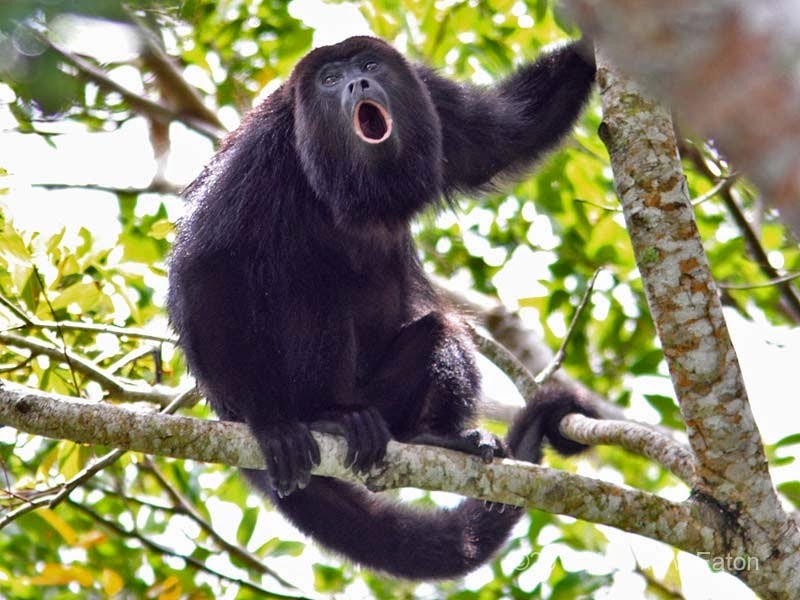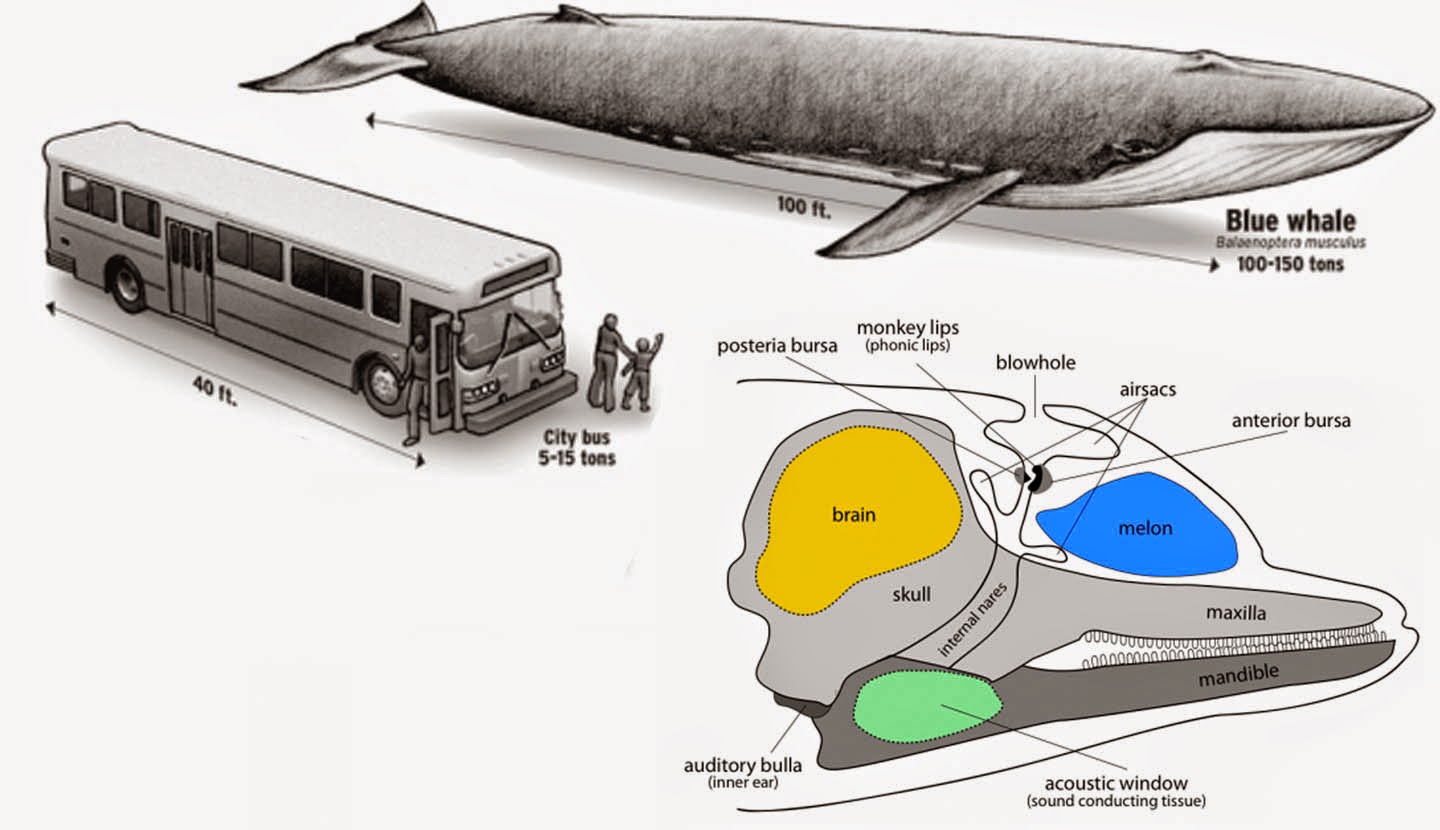Biology
Biology concepts ? vocalizations, mechanical sounds, sonar, decibels, stridulation
I have worked for years in science, and I?m supposed to be a big boy and realize that things are complicated. But I still get frustrated when I can?t get a simple answer. It seems nothing's simple, every answer has a caveat ? heck, I make a blog of the exceptions to answers!
So now we have a sound wave, but do we have a sound? It?s like the old question, if a tree falls and nobody?s there to hear it, does it make a sound? If you define a sound as a sound wave, then yes it does. Does that mean that every sound wave is a sound? There are sounds waves that dogs hear and we don?t because the frequency is too high ? are they sound? There are waves that are too low or too soft for anything to hear, are they still sounds?
Examples of things that are loud (high sound pressure) would be a jet taking off 25 meters away (150 db), a clap of very nearby thunder (120 db), or a Harley Davidson 25 feet away (70 db). Note the distances; sound waves dissipate in power as they travel, the transference of energy along the wave goes in all directions and is not 100% efficient. This is why you can?t hear your brother playing with your Rock?em Sock?em Robots when you?re down the hall.
They howl most often in defense of feeding areas. The volume of the howl makes the monkey seem bigger than he/she is. They also use it to defend infants or mates from males that are not part of the group. It calls attention and help comes a runnin?.
The blue whale(Balaenoptera musculus) is the largest living animal and the heaviest animal ever to live on Earth (yet). The whale?s song can reach 188 db! Some of the frequencies are too low for us to hear, but the higher pitched (higher energy) sounds can be detected 800 km (497 miles) way (hear it here).
But for interesting and functional loud noise, I like to go with the pistol shrimp (family Alpheidae, hundreds of species). A special engineering twist allows them to cock one pincher like a gun. When they release it, the sound wave travels so forcefully and fast that the water around it turns to vapor and a cavitation bubble is produced (see video). The temperature in the immediate vicinity reaches 4000?C and prey within 1.8 meters is stunned or killed! The sound, from several inches away, is 218 db (before subtracting the 61.5 db to match air measurements) when the bubble collapses.
Van Belle S, Estrada A, & Garber PA (2014). The function of loud calls in black howler monkeys (Alouatta pigra): Food, mate, or infant defense? American journal of primatology PMID: 24865565
Sueur J, Mackie D, & Windmill JF (2011). So small, so loud: extremely high sound pressure level from a pygmy aquatic insect (Corixidae, Micronectinae). PloS one, 6 (6) PMID: 21698252
McDonald, M., Hildebrand, J., & Mesnick, S. (2009). Worldwide decline in tonal frequencies of blue whale songs Endangered Species Research, 9, 13-21 DOI: 10.3354/esr00217
Anker A, Ahyong ST, Noël PY, & Palmer AR (2006). Morphological phylogeny of alpheid shrimps: parallel preadaptation and the origin of a key morphological innovation, the snapping claw. Evolution; international journal of organic evolution, 60 (12), 2507-28 PMID: 17263113
- The Most: Related To Animals -6 (mammals)
Blue whale 1. Commonest animal Homo sapiens (man) 2. Fastest animal Cheetah, Acinonyx jubatus (112 km/hr) (found in Africa, Middle East, W. Asia) 3. ...
- Amazing Facts About Amphibians
Some frogs can be frozen solid, then thawed, and continue living.Some frogs can pull their eyes into their throat and help push food down!Frogs live on all continents except Antarctica.Wood frogs can be frozen solid and then thawed, and continue living....
- Amazing Facts About Aquatic Animals
Animals with some of the longest lives are the Marion?s tortoise (152 years), the fin whale (116 years) and the deep-sea clam (100 years).There are about 40 species or kinds of porpoises and dolphins.Porpoises and dolphins communicate with each other...
- Do You Have Be Ugly To Hear Well? ? Owls And Body Plan Symmetry
Biology concepts ? body plan, bilateral symmetry, cephalization, form follows function Paradox alert ? the most complex organisms in nature are the best at reducing complexity. How is that? Nature tends toward symmetry through evolution. Lower organisms...
- Your Ears Hear, But Can You Hear Your Ears?
The auditory mechanism is very smalOf your 10 or 11 senses (remember last week? ? sight, hearing, taste, smell, touch, hot, cold, pain, kinesthetic awareness, balance, and maybe proprioception), hearing and sight have the most complex mechanisms. This...
Biology
Let's Get Loud
Biology concepts ? vocalizations, mechanical sounds, sonar, decibels, stridulation
 |
| Today it seems that truth is more complex than ever. van Goethe was a German statesman and a very successful writer. He wrote novels, scientific treatises, lyric poems, as well as dramas. Born in 1749, one might say that his quote was true for his day; it was a simpler time. But think how simple our time will seem to those who live a hundred years from now ? unless we?ve found our way back to the Stone Age. |
This week?s question is no exception ? What living thing makes the loudest sound? Notice I said living thing, because I didn?t want to exclude anyone from the contest. Who knows, maybe some bacterium living in Wyoming makes a heck of a racket, it?s just that nobody is around to hear it. Or maybe a redwood falling down is the loudest. See, nothing?s ever simple.
This leads us to a second question ? one which we have to answer first. What?s a sound? We are surrounded by air, and air has mass and density ? it?s stuff. You can push stuff around. When you push the air, it moves away, which creates a wave, because the air you move then moves the air next to it, and so on.
A sound wave is generated when a force creates a vibration, and that vibration moves air, and that vibration is then propagated through the air. The air moves in the same direction the vibration was moving, and this makes it a longitudinal wave (see animation below).
 |
| A sound wave is a longitudinal wave, where the source moves in the same direction as the wave. There is a compression of the medium (air or water) and then a rarefaction with fewer molecules as the compression moves on. The wavelength is the distance between compressions and the frequency (how high or low the sound is) is 1/wavelength. |
If you define sound as something your brain recognizes, then a sound doesn?t occur until the sound wave is transduced (changed in form) by a your ear to an electrical chemical impulse and that impulse is interpreted by the auditory cortex of your brain. See, nothing has a simple answer.
So, does a lonely falling tree make a sound? Scott McFarland of the University of Oregon installed microphones all over Crater Lake National Park 100 miles southeast of Eugene. In the remotest parts of the preservation land, he has heard everything from buzzing mosquito wings to, yes, falling trees. Unfortunately, he has also heard human intrusion.
Even from the most isolated areas, about 20% of every recording included airplane noise. He also heard cars, people, and detonations. It seems that no place is really naturally quiet anymore. But there were those falling trees -does that mean they do make a sound? Nope, it was a sound wave captured by recording equipment, transduced to digital information, stored, changed back to a sound wave by a speaker, and then to a neural impulse by our inner ear. It still isn?t interpreted as a sound until it reaches a brain, any brain. If a rabbit or bull moose is nearby, their ears would transduce the sound wave and they would ?hear? something, even if they don?t think to themselves, ?Hey, a tree just fell.? So again, it?s not so simple, maybe something with a functioning ear is in range.
 |
| The old tree falls in a forest question started out as a philosophical question. It was meant as a thought experiment to students to discuss the nature of what is real versus what is observable. However, when it existed as a philosophical question, no mention of sound was made, but was concerned with whether the tree existed at all if no one was there to perceive it. It wasn?t until 1883 that the sound reference was made, and then it was posed as more of a scientific question, as we approach it in today?s post. |
The human hearing sense is pretty sensitive. The pressure needed to generate a sound wave that a human could hear is about one billionth the value of atmospheric pressure. But this sound wave would be just barely audible (depending on the frequency), so it would be soft.
This brings us to a very short discussion of what it means to be loud or soft. We often measure loudness in decibels (db). A decibel is one tenth (deci) of a bel (named for Alexander Graham Bell), which is a unit of power or intensity.
Every 10 db increase represents a 10 fold change in intensity, so the scale is logarithmic. In acoustics(from Greek akoustos = hearing, and ic= pertaining to) this means that decibel is a measure of sound pressure, compared to a reference pressure (20 micropascals ? we?ll get back to this).
 |
| Howler monkeys are the largest of the New World monkeys. But in one way they are like old world primates. Howlers are the only new world monkeys with color vision in both males and females. They all see like we see, so they can discriminate different shades of green, red, and blue. In most new world monkeys, the color receptor gene is on the X chromosome, so females may get two types and be color vision function, but all males get only one, and see only black and white. A fairly recent gene duplication in howlers have given it color vision again. |
So who?s the loudest? The howler monkey (genus Alouatta, 15 species) has a great claim to being the loudest living thing. Used for communication over tremendous distances, the howl of this primate reaches 128 db from several feet away (hear it here). Howlers have an enlarged hyoid bone that is U-shaped. This creates an air sac on their throat that they can use to make their howl resonate.
The howl is really more of a growl for males but is higher pitched for females, and they can be heard more than 3.5 miles away. The question is why do they do it. A 2014 study concluded that the black howler monkey (Alouatta pigra) use their calls for several reasons, but most relate to defense.
 |
| The lesser water boatman (Micronecta scholtzi) is only 2 mm long, but packs a big auditory punch. It?s a freshwater (aquatic rather than marine) insect. Many marine animals have loud calls, but here is an example of one that lives in slow moving streams and ponds. You can hear it when standing on the bank. This means the sound is so loud it can traverse the water/air boundary, which usually stops most sounds. |
If we look at smaller land animals, some of them are loud too. Cicadas can produce stridulations (see this post) that reach 100 db from a foot away. But the king of the small animals would be the lesser water boatman.
This small freshwater insect (Micronecta scholtzi) can put out a stridulation of 105 db, even though it?s entire body is only 2 mm (0.078 in) long! A 2011 paper in PLoS One broke down the song of the male into three different parts, each with its own peak intensity. The loudest part could be heard from a riverside, even though the insect is underwater. By comparing peak db to size, the male outcalls every other organism we will discuss.
But it?s only the male that calls so loud. Why? Because he?s looking for a mate, and it?s his penis rubbing against his abdomen that makes the stridulation. This sort of eliminates the females from participating in the contest.
But back to the bigger animals. Bats are extremely loud, but their calls are of such high frequency that we can't hear them. Parrots can call to each other in the range of 100 db, but we can go bigger. In fact, the biggest animal may have the biggest voice as well.
 |
| The blue whale is the heaviest animal to yet live on Earth. Being this large, it still has two natural enemies ? man, who hunted it to near extinction, and the orca. Orcas coordinate their attacks on the blue behemoths, often trying to separate babies from their mothers. Nearly 25% of sighted blue whales have scars from either orcas or monumentally stupid octopus. |
Interestingly, a 2009 study shows that blue whale songs are getting lower in frequency. Since the whaling ban of 1966, male blue whale songs have been using lower and lower tones. The authors suggest several reasons for this. Males may not need to call out so loudly to find females because the ban has resulted in higher numbers of whales. But it is also possible that more man made noise in the ocean is forcing them to use lower frequencies.
The sperm whale is right there too. It doesn?t really vocalize, but it makes clicks to echolocate each other and prey. The clicks are made by forcing air through two lips (folds of tissue) in front of their blowhole. These clicks come in several varieties, but the ?usual? click can reach 230 db. This makes them the kings of sound, if you don?t limit your choices to sounds made with the mouth.
Sounds in water are louder than in air, because the density is higher and the transmission is more efficient. So decibels in water are relative to 1 millipascal instead of the 20 micropascals in air. If you want to compare directly, you need to subtract 61.5 db from the water sounds. This still makes the sperm whale clicks 170 db and the blue whale song about 127 db, just about the howler monkey level. So the sperm whale wins our contest.
 |
| The different pistol or mantis shrimp are not very large, but they have second largest sound to size ratio in the natural world. Only one claw is the pistol. The right image is an enlargement of the claw. S= socket, pl = plunger, D= dactyl, p = propus. The muscles of the dactyl close it so fast, that the water displaced in the socket by the plunger shoots out at 100 km/hr. This produces the cavitation bubble. |
A 2006 study describes that the hoods of the carapace (shell) that partially cover the eyes of the pistol shrimp are to protect themselves from their own explosive snap. The study suggests the hoods evolved first, and that allowed for the development of stronger and stronger snaps. If this continues, the pistol shrimp may start taking humans out!
Next week, another question about the extremes of life.
- The Most: Related To Animals -6 (mammals)
Blue whale 1. Commonest animal Homo sapiens (man) 2. Fastest animal Cheetah, Acinonyx jubatus (112 km/hr) (found in Africa, Middle East, W. Asia) 3. ...
- Amazing Facts About Amphibians
Some frogs can be frozen solid, then thawed, and continue living.Some frogs can pull their eyes into their throat and help push food down!Frogs live on all continents except Antarctica.Wood frogs can be frozen solid and then thawed, and continue living....
- Amazing Facts About Aquatic Animals
Animals with some of the longest lives are the Marion?s tortoise (152 years), the fin whale (116 years) and the deep-sea clam (100 years).There are about 40 species or kinds of porpoises and dolphins.Porpoises and dolphins communicate with each other...
- Do You Have Be Ugly To Hear Well? ? Owls And Body Plan Symmetry
Biology concepts ? body plan, bilateral symmetry, cephalization, form follows function Paradox alert ? the most complex organisms in nature are the best at reducing complexity. How is that? Nature tends toward symmetry through evolution. Lower organisms...
- Your Ears Hear, But Can You Hear Your Ears?
The auditory mechanism is very smalOf your 10 or 11 senses (remember last week? ? sight, hearing, taste, smell, touch, hot, cold, pain, kinesthetic awareness, balance, and maybe proprioception), hearing and sight have the most complex mechanisms. This...
